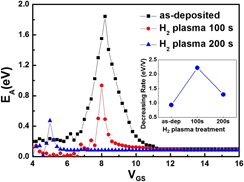Crossref Citations
This article has been cited by the following publications. This list is generated based on data provided by
Crossref.
Oh, Se-I
Choi, Godeuni
Hwang, Hyunsang
Lu, Wu
and
Jang, Jae-Hyung
2013.
Hydrogenated IGZO Thin-Film Transistors Using High-Pressure Hydrogen Annealing.
IEEE Transactions on Electron Devices,
Vol. 60,
Issue. 8,
p.
2537.
Raja, Jayapal
Jang, Kyungsoo
Balaji, Nagarajan
and
Yi, Junsin
2013.
Suppression of temperature instability in InGaZnO thin-film transistors by in situ nitrogen doping.
Semiconductor Science and Technology,
Vol. 28,
Issue. 11,
p.
115010.
Kim, Jae-sung
Oh, Byung Su
Piao, Mingxing
Joo, Min-Kyu
Jang, Ho-Kyun
Ahn, Seung-Eon
and
Kim, Gyu-Tae
2014.
Effects of low-temperature (120 °C) annealing on the carrier concentration and trap density in amorphous indium gallium zinc oxide thin film transistors.
Journal of Applied Physics,
Vol. 116,
Issue. 24,
Nag, Manoj
Steudel, Soeren
Bhoolokam, Ajay
Chasin, Adrian
Rockele, Maarten
Myny, Kris
Maas, Joris
Fritz, Thomas
Trube, Jutta
Groeseneken, Guido
and
Heremans, Paul
2014.
High performance a‐IGZO thin‐film transistors with mf‐PVD SiO2 as an etch‐stop‐layer.
Journal of the Society for Information Display,
Vol. 22,
Issue. 1,
p.
23.
Kim, Jae-Sung
Joo, Min-Kyu
Xing Piao, Ming
Ahn, Seung-Eon
Choi, Yong-Hee
Jang, Ho-Kyun
and
Kim, Gyu-Tae
2014.
Plasma treatment effect on charge carrier concentrations and surface traps in a-InGaZnO thin-film transistors.
Journal of Applied Physics,
Vol. 115,
Issue. 11,
Hwang, Yeong-Hyeon
An, Ho-Myoung
and
Cho, Won-Ju
2014.
Performance improvement of the resistive memory properties of InGaZnO thin films by using microwave irradiation.
Japanese Journal of Applied Physics,
Vol. 53,
Issue. 4S,
p.
04EJ04.
Li, Min
Xu, Miao
Zou, Jianhua
Tao, Hong
Wang, Lei
Xu, Ruixia
Zhang, Yanli
and
Peng, Junbiao
2014.
Influence of passivation deposition on the performance of In-Zn-O thin-film transistors based on etch-stopper structure.
Materials Research Express,
Vol. 1,
Issue. 3,
p.
036402.
Socratous, Josephine
Banger, Kulbinder K.
Vaynzof, Yana
Sadhanala, Aditya
Brown, Adam D.
Sepe, Alessandro
Steiner, Ullrich
and
Sirringhaus, Henning
2015.
Electronic Structure of Low‐Temperature Solution‐Processed Amorphous Metal Oxide Semiconductors for Thin‐Film Transistor Applications.
Advanced Functional Materials,
Vol. 25,
Issue. 12,
p.
1873.
Nag, Manoj
Bhoolokam, Ajay
Steudel, Soeren
Chasin, Adrian
Maas, Joris
Genoe, Jan
Murata, Mitsuhiro
Groeseneken, Guido
and
Heremans, Paul
2015.
Medium Frequency Physical Vapor Deposited Al2O3and SiO2as Etch-Stop-Layers for Amorphous Indium-Gallium-Zinc-Oxide Thin-Film-Transistors.
ECS Journal of Solid State Science and Technology,
Vol. 4,
Issue. 5,
p.
Q38.
Nag, Manoj
Bhoolokam, Ajay
Steudel, Soeren
Genoe, Jan
Groeseneken, Guido
and
Heremans, Paul
2015.
Impact of the Low Temperature Gate Dielectrics on Device Performance and Bias-Stress Stabilities of a-IGZO Thin-Film Transistors.
ECS Journal of Solid State Science and Technology,
Vol. 4,
Issue. 8,
p.
N99.
Chowdhury, Md Delwar Hossain
Mativenga, Mallory
Jae Gwang Um
Mruthyunjaya, Ravi K.
Heiler, Gregory N.
Tredwell, Timothy John
and
Jin Jang
2015.
Effect of SiO<sub>2</sub> and SiO<sub>2</sub>/SiN<sub><italic>x</italic></sub> Passivation on the Stability of Amorphous Indium-Gallium Zinc-Oxide Thin-Film Transistors Under High Humidity.
IEEE Transactions on Electron Devices,
Vol. 62,
Issue. 3,
p.
869.
Chin, Huai-Shan
Chao, Long-Sun
and
Wu, Chia-Ching
2016.
Crystal, optical, and electrical characteristics of transparent conducting gallium-doped zinc oxide films deposited on flexible polyethylene naphthalate substrates using radio frequency magnetron sputtering.
Materials Research Bulletin,
Vol. 79,
Issue. ,
p.
90.
Chang, Kow-Ming
Huang, Bo-Wen
Wu, Chien-Hung
Chen, Hsin-Ying
Zheng, You-Xian
Lee, Ming-Chuan
Zhang, Yu-Xin
Lin, Chuang-Ju
Cheng, Yu-Hsuan
Wang, Shui-Jinn
Hsu, Jui-Mei
and
Lin, Yu-Li
2016.
The investigation for In-Ga-Zn-O TFTs with post deposition of in-situ Ar/H<inf>2</inf> plasma treatment by atmospheric pressure plasma Jet.
p.
405.
Miyakawa, Masashi
Nakata, Mitsuru
Tsuji, Hiroshi
Fujisaki, Yoshihide
and
Yamamoto, Toshihiro
2016.
Application of hydrogen injection and oxidation to low temperature solution-processed oxide semiconductors.
AIP Advances,
Vol. 6,
Issue. 8,
Liu, Po-Tsun
Chang, Chih-Hsiang
Fuh, Chur-Shyang
Liao, Yu-Tei
and
Sze, Simon M.
2016.
Effects of Nitrogen on Amorphous Nitrogenated InGaZnO (a-IGZO:N) Thin Film Transistors.
Journal of Display Technology,
Vol. 12,
Issue. 10,
p.
1070.
Yun, Da-Jeong
Kang, Han-Byeol
and
Yoon, Sung-Min
2016.
Process Optimization and Device Characterization of Nonvolatile Charge Trap Memory Transistors Using In–Ga–ZnO Thin Films as Both Charge Trap and Active Channel Layers.
IEEE Transactions on Electron Devices,
Vol. 63,
Issue. 8,
p.
3128.
Abliz, Ablat
Wang, Jingli
Xu, Lei
Wan, Da
Liao, Lei
Ye, Cong
Liu, Chuansheng
Jiang, Changzhong
Chen, Huipeng
and
Guo, Tailiang
2016.
Boost up the electrical performance of InGaZnO thin film transistors by inserting an ultrathin InGaZnO:H layer.
Applied Physics Letters,
Vol. 108,
Issue. 21,
Ogura, Shintaro
Cheong, Heajeong
Uemura, Sei
Ushijima, Hirobumi
and
Fukuda, Nobuko
2016.
Flexible InGaZnO TFT devices obtained via humid-UV irradiation with an aqueous-fluoroalcoholic precursor.
Flexible and Printed Electronics,
Vol. 1,
Issue. 4,
p.
045001.
Kumar, Narendra
Sutradhar, Moitri
Kumar, Jitendra
and
Panda, Siddhartha
2017.
Role of deposition and annealing of the top gate dielectric in a-IGZO TFT-based dual-gate ion-sensitive field-effect transistors.
Semiconductor Science and Technology,
Vol. 32,
Issue. 3,
p.
035013.
Abliz, Ablat
Gao, Qingguo
Wan, Da
Liu, Xingqiang
Xu, Lei
Liu, Chuansheng
Jiang, Changzhong
Li, Xuefei
Chen, Huipeng
Guo, Tailiang
Li, Jinchai
and
Liao, Lei
2017.
Effects of Nitrogen and Hydrogen Codoping on the Electrical Performance and Reliability of InGaZnO Thin-Film Transistors.
ACS Applied Materials & Interfaces,
Vol. 9,
Issue. 12,
p.
10798.



